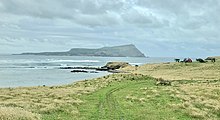 Map showing location of South East Island/Rangatira Map showing location of South East Island/Rangatira | |
| Geography | |
|---|---|
| Coordinates | 44°20′47″S 176°10′20″W / 44.3465°S 176.1721°W / -44.3465; -176.1721 |
| Archipelago | Chatham Islands |
| Area | 2.18 km (0.84 sq mi) |
| Highest point | 224 |
| Administration | |
| New Zealand | |
| Demographics | |
| Population | 0 |
Hokorereoro, Rangatira, or South East Island is the third largest island in the Chatham Islands archipelago, and covers an area of 218 hectares (539 acres). It lies 800 kilometres (497 mi) east of New Zealand's South Island off the south-east coast of Pitt Island, 55 kilometres (34 mi) south-east of the main settlement, Waitangi, on Chatham Island.

History
According to oral traditions, ancient Moriori used to travel to Rangatira by canoe to capture muttonbirds. However, there is no material evidence of those expeditions, such as dendroglyphs (tree carvings) or petroglyphs (rock art).
European farmers ran sheep, goats and cattle on Rangatira until the 1960s when the last of these were removed. Today the island is a gazetted nature reserve, and access to the island is restricted and controlled by the Department of Conservation.
Scientific expedition
In 1954 scientists on the 1954 Chatham Islands expedition visited the island.

Flora and fauna
Rangatira is host to several rare and endemic species of birds and plants, and is a sanctuary for endangered invertebrates such as the giant stick insect, coxella weevil, the flightless rove beetle Creophilus rekohuensis, and the Pitt Island longhorn beetle. It is also locally notorious for the presence of the Rangatira spider, one of New Zealand's largest spiders.
Rangatira is most famous for being the habitat for the endangered black robin, rescued from near extinction by a dedicated team led by Don Merton, who used foster parent birds to raise the chicks of black robin. The island has been identified as an Important Bird Area by BirdLife International because it supports large breeding colonies of broad-billed prions (330,000 pairs), Chatham petrels (up to 1000 pairs) and white-faced storm petrels (840,000 pairs). Rangatira was the stronghold and last remaining breeding site for the Chatham petrel until recently; new colonies on Pitt and Chatham Islands are being established.
For a 1994 account of the birdlife of Rangatira, see Nilsson et al.
See also
References
- G A Knox (1957). "General account of the Chatham Islands 1954 Expedition" (PDF). New Zealand Oceanographic Institute Memoir. 2: 1–37. ISSN 0083-7903. Wikidata Q66412141.
- "Expedition to the Chathams". Press. 24 March 1954. p. 10. Retrieved 28 July 2024 – via Papers Past.
- Rangatira (South East Island). Department of Conservation.
- Miskelly, Colin (13 April 2018). "Giant spiders and other critters of Rangatira Island, Chatham Islands". Te Papa’s Blog. Retrieved 3 December 2019.
- "Chatham Islands (South East Island / Rangitira)". BirdLife data zone: Important Bird Areas. BirdLife International. 2012. Retrieved 18 November 2012.
- "Magenta Petrel (Pterodroma magentae) - BirdLife species factsheet".
- Nilsson, Ron J.; Kennedy, Euan S.; West, Jillian A. (1994). "The Birdlife of South East Island (Rangatira), Chatham Islands, New Zealand" (PDF). Notornis. 41 (Supplement). Ornithological Society of New Zealand: 109–125.
External links
| Chatham Islands | ||
|---|---|---|
| Islands (by English name) |  | |
| Islands (by Māori/Moriori name) | ||
| Coastal landforms | ||
| Populated places | ||
| Other geographic features | ||
| Historical events | ||
44°20′47″S 176°10′20″W / 44.3465°S 176.1721°W / -44.3465; -176.1721
Categories: